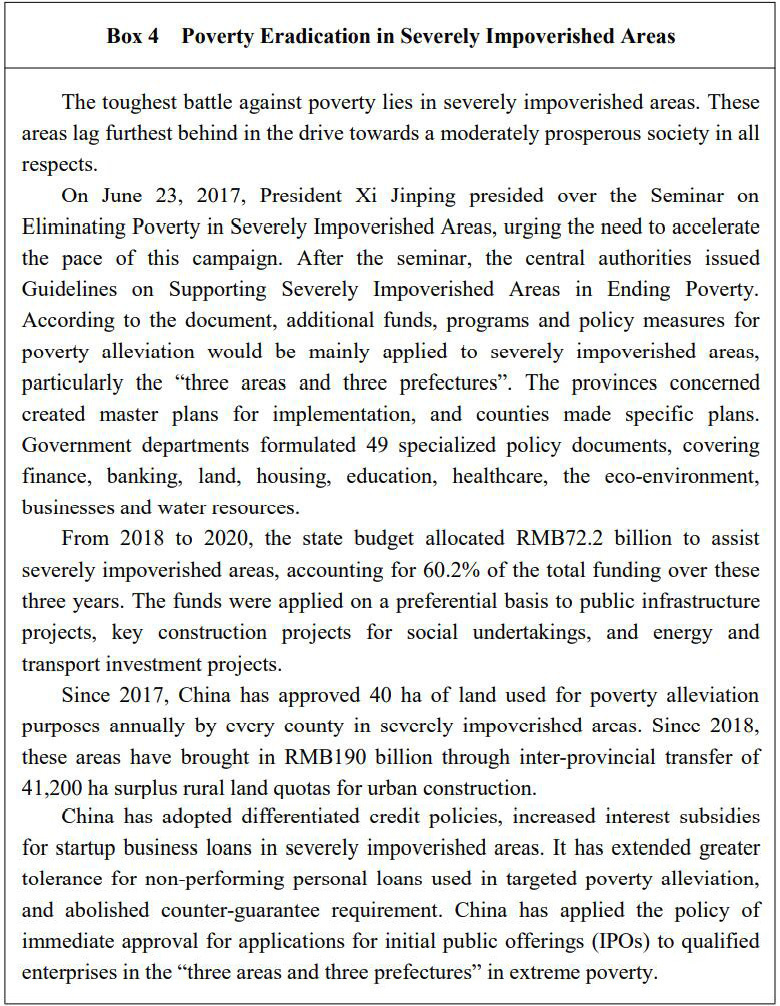Full Text: Poverty Alleviation: China's Experience and Contribution
The State Council Information Office of the People's Republic of China on Tuesday released a white paper titled "Poverty Alleviation: China's Experience and Contribution."
II.Final Victory in the Fight Against Extreme Poverty
China's fight against poverty entered a critical stage after the 18th CPC National Congress in 2012. At the end of 2020, through eight years of hard work, China achieved the goal of eliminating extreme poverty – a key goal for the new era of building socialism with Chinese characteristics. The 98.99 million people in rural areas who were living below the current poverty threshold all shook off poverty (Figure 1); all the 128,000 impoverished villages and 832 designated poor counties got rid of poverty (Figure 2). China has eliminated poverty over entire regions and eradicated extreme poverty.
The battle against poverty has been another great revolution in rural China, leading to historic and comprehensive changes. The campaign saw an end to the backwardness of poverty-stricken areas, boosted overall rural development, resolved the greatest threat to success in achieving moderate prosperity in all respects, and laid a solid foundation for building a modern socialist China and realizing the Second Centenary Goal. China has secured a complete victory in the battle against extreme poverty, eliminating overall and extreme poverty for the first time in its history of thousands of years, and realizing a century-long aspiration of the Chinese people.

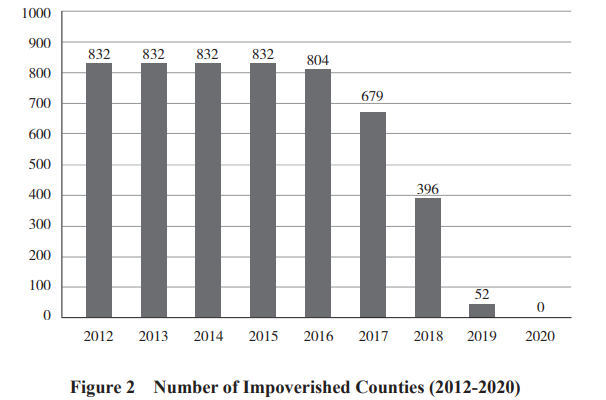
1. Significant Improvement in the Living Standards of the Poor
Through poverty alleviation, there has been a substantial improvement in the incomes and welfare of the poor. The Two Assurances and Three Guarantees[ This refers to assurances of adequate food and clothing, and guarantees of access to compulsory education, basic medical services and safe housing for impoverished rural residents. ] have been realized; education, healthcare, housing and drinking water supplies are much improved. These provisions have covered all basic needs and laid the foundations for future development. The fight against poverty has led to dramatic changes in the lives of the impoverished.
The incomes of the impoverished are increasing (Figure 3). The per capita disposable income of the rural poor increased from RMB6,079 in 2013 to RMB12,588 in 2020, up by 11.6% per annum on average. The growth rate was 2.3 percentage points higher than the national rural average. Their salary income and operative income kept increasing over the years in proportion to their transfer income, showing a stronger ability to shake off poverty through their own efforts.
Ethnic minority areas have made notable progress in fighting poverty. From 2016 to 2020, in the five autonomous regions (Inner Mongolia, Guangxi, Tibet, Ningxia and Xinjiang) and three provinces with a large multi-ethnic population (Guizhou, Yunnan and Qinghai), the number of the poor dropped by 15.6 million. Extreme poverty was eliminated in all 28 of the minority ethnic groups with a small population. Some ethnic groups, still at the later stage of primitive society when the PRC was founded in 1949, leapfrogged to socialism and then again made great strides towards moderate prosperity in all respects.
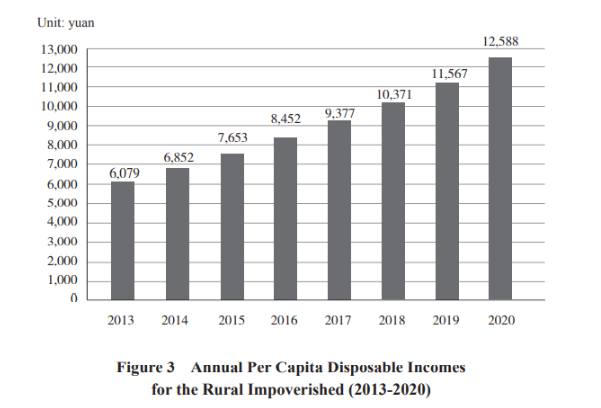
The Two Assurances and Three Guarantees have been realized. According to the national survey of poverty alleviation[ The national survey of poverty alleviation is a full review of China's progress in fighting poverty and has a fundamental importance for targeted poverty alleviation. From 2020 to 2021, the survey was conducted in 22 provinces and equivalent administrative units in central and western China, focusing on the veracity of poverty alleviation results, particularly the overall progress in designated poor counties. The survey includes registration of poverty-stricken populations, progress in the Two Assurances and Three Guarantees, participation of the impoverished in poverty alleviation programs, and basic public services in poor counties and villages. ], poor households now have adequate food and clothing all year round and a proper supply of nutritious food. They have clothing for all four seasons and comforters that protect them from cold weather.
Access to good quality education for the impoverished has improved remarkably; there are no dropouts in the countryside due to financial difficulties; nine-year compulsory education is now available to all children from rural poor households, and the completion rate in 2020 was 94.8%.
The three-tier healthcare system at village, township and county levels has been improved. All poverty-stricken populations now have access to basic medical insurance, critical illness insurance, and medical assistance, to ensure medical treatment to the impoverished with major illnesses, contracted healthcare to the impoverished with chronic diseases, and guaranteed medical services for the impoverished with critical illnesses. Basic medical insurance coverage of the poor is now over 99.9%. All the impoverished have been guaranteed medical services and medical insurance. Through these measures, China has resolved the problem of difficult and expensive access to medical treatment for poverty-stricken residents.
The program of renovation of dilapidated rural homes has ensured safe housing for all the impoverished (Box 1). The program of safe drinking water for rural residents has secured supplies to 28.89 million poor in terms of both quantity and quality, and benefited 382 million rural population; tap water coverage increased from 70% in 2015 to 83% in 2020.

2. Poverty-stricken Areas Rid of Backwardness
Poor areas have long suffered from weak infrastructure, inadequate public services, and social and economic underdevelopment. In the final stages of fighting poverty, China succeeded in raising all the rural poor out of extreme poverty and the impoverished areas achieved a big stride in economic and social development, taking on a brand new look.
Infrastructure has been improved. Lack of access to transport, electricity, drinking water and communications hinders the development of poverty-stricken areas. Infrastructure construction is a basic element in the battle against poverty; through an intensified effort and further investment, new infrastructure in poor areas boosted their social and economic development.
The construction, management, maintenance and operation of roads in rural areas have all seen significant improvement (Box 2). Transport networks now connect all villages with other local villages and with the outside world, and provide them with safe and easy access to bus services. By the end of 2020, impoverished areas had gained 1.1 million km of reconstructed highways and 35,000 km of new railways; all the villages, townships and towns in poverty-stricken areas with the right conditions were accessible by paved road and provided with bus and mail routes, which facilitated more economic development.
Water infrastructure in impoverished areas has been improved in many ways. Since 2016, the effective irrigated area has increased by more than 5.35 million ha and water supply capacity has increased by 18.1 billion cu m. Better water infrastructure is also a provider of strong support for the development of poverty-stricken areas.
Electricity access in poor areas has been improved through power grid construction projects such as power supply to areas without electricity, upgrading of rural power grids, and construction of trunk power grids and power transmission channels. Now, more remote areas are connected to power grids, and almost all rural areas enjoy a steady power supply (Box 3).
Communications infrastructure has been extended in poverty-stricken areas. Now, over 98% of poor villages have access to optical fiber communications (OFC) and 4G technology; distance education is available at more schools in impoverished areas; telemedicine and e-commerce cover all designated poor counties. All of this represents an unprecedented pace of development of IT application in poverty-stricken areas.
This comprehensive range of infrastructure improvements has resolved many historical problems trapping poor areas in poverty, facilitated the flows of personnel, logistics, knowledge and information between poor areas and the outside world, and provided solid support for social and economic development in impoverished areas.
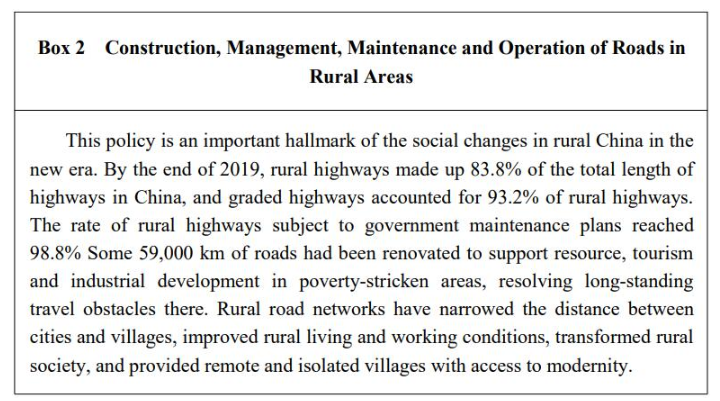
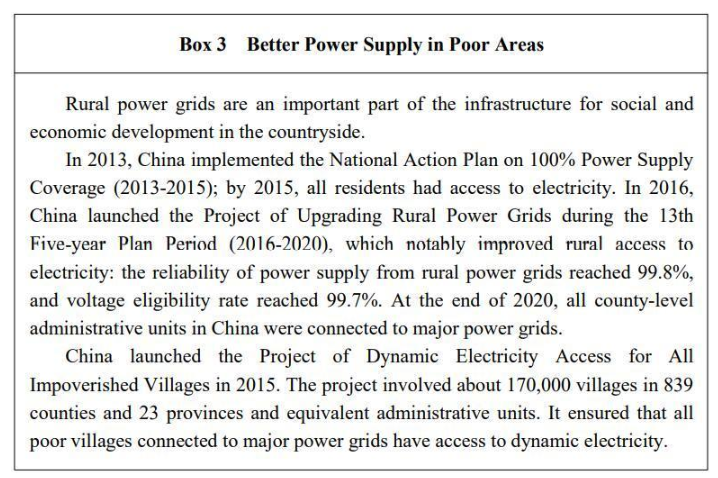
Basic public services have been improved. In addition to providing adequate food, clothing and safe housing for the impoverished, China has intensified efforts to improve basic public services covering education, healthcare, culture and social security. The goal is to guarantee impoverished people access to education, medical services, elderly care and social assistance, so as to support development in poverty-stricken areas.
Since 2013, China has renovated 108,000 schools to strengthen the provision of compulsory education in poor areas, and ensured that all school-age rural children receive kindergarten and elementary education within their own villages.
Public cultural services in poor areas have also been improved. By the end of 2020, 99.48% of villages in 22 provinces and equivalent administrative units in central and western China had seen their own cultural centers completed. The campaign of bringing culture to the countryside has enriched the cultural life of the rural poor.
There has been a notable improvement in healthcare provision in poor areas. This program has remedied the shortfall in medical workers and institutions at village and township level. 98% of the designated poor counties now have at least one grade-two hospital. The county-level hospitals in impoverished areas can treat 90% of the diseases that general county-level hospitals can. The impoverished can now have common ailments and chronic diseases treated at nearby medical institutions in a timely manner, and more major illnesses can be effectively treated at county-level hospitals.
Comprehensive social security systems are now in place in poor areas. The standards of eligibility for rural subsistence allowances in designated poor counties are all higher than the national poverty threshold.
Some 19.36 million impoverished people have been covered by rural subsistence allowances or extreme poverty relief funds, and 60.98 million by basic pension schemes for rural and non-working urban residents, achieving nearly 100% coverage.
The economy has achieved sustained and rapid growth. The battle against poverty has released the potential of poor areas, and injected vigor into their economic development.
Poverty-stricken areas have seen notable improvements in their economic structure. Businesses that leverage local strengths have been growing and thriving, including such new forms as e-commerce, photovoltaic technology, and tourism. The economy in poor areas has diversified, and effective market supply has increased. These developments provide solid foundations for economic growth.
The GDP of impoverished areas has maintained rapid growth. Since 2015, the average annual increment in per capita revenue from the national general public budget has been seven percentage points higher than the national average. A steady increase in incomes has created higher demand for life quality and cultural activities. This has stimulated a surge in consumption in rural areas, and provided support for the domestic economy.
Cultural heritage has been protected. China has strengthened the protection and promotion of traditional culture, folk culture and ethnic culture in poor areas to maintain a wealth of cultural diversity. It has implemented the Plan on the Revitalization of Traditional Chinese Craftsmanship to protect and develop fine craftsmanship in old revolutionary base areas, areas with large ethnic minority populations, border areas, and poverty-stricken areas. It has supported poor areas to develop cultural resources with local characteristics, including ethnic culture, revolutionary sites, folk culture, and intangible cultural heritage. Local governments in poor areas have developed tourism there by conserving and promoting these cultural resources and training support staff. China has paid attention to keeping a record of the experiences of ordinary people in poverty alleviation, such as archives of poor villages, films, TV programs and literary works themed on poverty alleviation. Through the protection and promotion of cultural heritage in poor areas, the impoverished have gained additional income while retaining their cultural roots.
The eco-environment has improved. China has integrated development-driven poverty alleviation with soil and water conservation and eco-environmental conservation. By developing the eco-economy, improving the rural living environment, and relocating the impoverished from inhospitable areas to places with better economic prospects, there have been remarkable improvements in the eco-environment of poverty-stricken areas. Lucid waters and lush mountains have become their invaluable assets. Through the fight against poverty, China has increased the incomes of the impoverished, improved the eco-environment of poor areas, and made the vast rural areas more livable spaces for their inhabitants.
Severely impoverished areas are the top priority in China's battle against poverty. The "three areas and three prefectures"[ The "three areas" refer to the Tibet Autonomous Region, the Hotan, Aksu, Kashgar prefectures and the Kizilsu Kirgiz Autonomous Prefecture in southern Xinjiang, and prefectures and counties with large Tibetan populations in the provinces of Sichuan, Yunnan, Gansu and Qinghai. The "three prefectures" refer to the Liangshan Yi Autonomous Prefecture in Sichuan Province, the Nujiang Lisu Autonomous Prefecture in Yunnan Province, and the Linxia Hui Autonomous Prefecture in Gansu Province. ] in extreme poverty have seen notable improvements in infrastructure, public services, and civil communal behavior, as well as rapid development in industries and businesses that leverage local strengths. All of these efforts have brought an end to regional and overall poverty (Box 4).
3. Those Who Have Been Lifted Out of Poverty Adopt a New Mindset
The battle against poverty is a profound revolution and complete victory on both material and theoretical level. Through this battle, the mindset of the poor has been enriched and sublimed – they have greater confidence, more active minds, and higher aspirations; they have experienced a thorough transformation from the inside to the outside.
The impoverished have a deep desire to rid themselves of the shackles of poverty and achieve prosperity. The poverty relief efforts have not only widened channels for the impoverished to improve their material welfare but rekindled their desire to seek a better life as well. Impoverished people have been inspired to seek prosperity through hard work, self-reliance, frugality and entrepreneurship, and strive for excellence. They are highly motivated and have more confidence about getting rid of poverty. As the Chinese people always say, "Good days come after hard work". They are ready to compete in the race to prosperity.
The impoverished have a stronger sense of self-reliance. The poverty alleviation work has set up a new platform for the impoverished to participate in collective affairs. When making major decisions on the implementation of poverty relief projects and the use of funds at the village level, villagers have carried out a "4+2" system[ "4+2" system refers to the democratic policy-making process on village affairs under the leadership of village Party organizations. "4" means four steps: Proposals should be put forward by the Party branch, jointly discussed by the village committee and the Party branch, and deliberated by Party members, and resolutions should be adopted by villagers' representatives; "2" means transparency on two levels – resolutions and implementation results should be made known to the public. ]. The oversight mechanisms for village affairs and villagers' councils and poverty relief councils have been improved to ensure that public affairs are discussed and handled by everyone. Under these arrangements, the impoverished have participated more in the decision making and implementation process in the battle against poverty. They have been more motivated to participate actively in collective affairs, more enthusiastic to build up their hometown, and more cohesive to develop the countryside.
The impoverished have been constantly upgrading their mindsets. The battle against poverty has opened the door to the outside world for poverty-stricken areas. Improvements in transport infrastructure have established links between poor areas and the outside world; development of public cultural undertakings has enriched the cultural life of impoverished people; with better access to the internet, the poor have greater knowledge, broader horizons, and a deeper understanding of openness, innovation, technology, rules and markets. They are capable of generating more ideas and opening wider channels for poverty alleviation.
Cultural and ethical work has been advancing in impoverished regions. Civility villages and towns are being built in poverty-stricken areas, and civil families cultivated under the "Five Family Virtues" program (encouraging respect for the law, diligent study, family planning, domestic harmony, and industrious and thrifty management of the household). Social etiquette, village rules, agreements among villagers, and councils on moral issues, weddings and funerals have been promoted, to update outmoded and undesirable habits and customs. Activities, such as competition for best households and families, have been organized to carry forward cherished family traditions, spread core socialist values, and enhance social etiquette and civility. Scientific, healthy and civilized new ways of life which are simple, green, eco-friendly, and hygienic have been embraced by the villagers. Good social practices, including modest weddings and funerals, filial piety, harmonious neighborhoods, and helping the needy, the weak and the disabled, have been promoted. In the new era, new cultural practices with a local and modern essence are developing in rural areas.
4. Protecting the Rights of Special Groups to Basic Needs and Development
China prioritizes the basic rights of subsistence and development of the disadvantaged groups among women, children, the elderly, and the disabled. The nation has enacted favorable policies and provided more assistance to raise the welfare level of these groups.
Living conditions of impoverished women have been improving. China adheres to the fundamental national policy of gender equality, and sees women as a key target in poverty alleviation. Among nearly 100 million who have shaken off poverty, women account for half. By implementing the Outline of Women's Development in China (2011-2020), China has given priority to helping women alleviate poverty and reducing the number of women in poverty, given preferential treatment to women when making poverty alleviation policies, allocated funds and taken measures, and helped them solve the most difficult, most worrying and most pressing problems. A total of 10.21 million impoverished women have received skills training, over 5 million of whom have increased their incomes through activities such as handicrafts, crop and animal husbandry, housekeeping and e-business. Small-sum guaranteed loans and micro credit amounting to more than RMB450 billion have been provided to impoverished women, which have helped 8.7 million women to start businesses and increase their incomes. China has assisted 192,000 women who suffer from poverty and diseases and launched a program of free cervical and breast cancer checkups to cover all women in poverty-stricken areas. RMB4.17 billion has been invested in titled campaigns to provide 50 million impoverished mothers in impoverished areas with infrastructure and health benefits, as well as daily necessities.
Extending greater care to deprived children. China has implemented the Outline on the Development of Chinese Children (2011-2020) and the National Development Plan for Children in Poor Areas (2014-2020) to provide security for children's education and health and deliver interventions when required. Efforts have been made to popularize knowledge on children's nutrition and health. Following the implementation of nutritional improvement projects for children in impoverished areas, children in these regions now enjoy better health. The government gives a free daily pack of nutritional dietary supplements to every baby and toddler aged 6-24 months in contiguous destitute areas. By the end of 2020, a total of 11.2 million children in those areas had benefitted from this project. Birth defect prevention & relief programs have been launched to help cover medical expenses for children who suffer from poverty and serious diseases such as congenital malformations, some inherited metabolic disorders, and thalassemia. A total of RMB470 million has been allocated for the care of 41,000 sick children. China has organized volunteers to pair up with orphans, deprived children, and children of migrant workers left at home in the countryside, providing care and help to 25.19 million children and parents. More than 280,000 children's homes and over 1,200 children's happy homes have been built to give entertainment, psychological counseling, life care and tutoring to deprived children and children of migrant workers left at home in the countryside. China continues to improve the protection of orphans' rights and interests, with monthly allowance for orphans in welfare institutions and families that provide temporary care totaling RMB1,611 and RMB1,184 per person respectively. China has invested RMB1.7 billion in the Tomorrow Plan for Rehabilitation of Handicapped Orphans to offer operations and rehabilitation to 223,000 orphans with disabilities. RMB540 million from the public welfare has been used to carry out a program to support school education for 54,000 orphans. A support system for de facto orphans has been established in China to cover 253,000 such children.
Continuing to provide services and improve the lives of impoverished senior citizens. China has raised the amount of basic pension in rural areas and subsidies for basic medical insurance for poor seniors to further reduce poverty among the elderly in rural areas. The subsidy system for the poor population of advanced age and incapacitated seniors has been put in place, benefiting 36.89 million people. The government has initiated a program for the elderly in the western regions to promote health awareness among seniors in poverty-stricken areas, and organized medical workers and volunteers to provide free medical services and offer advice on health matters. China has developed a system to support and care for elderly people left behind by their families in the countryside after their grown-up children have moved to the cities in search of employment. It has shifted the focus of medical security for the impoverished elderly from medical treatment to health services. More care has been provided for incapacitated seniors living below the poverty line. On the basis of an overall inspection, China has verified 627,000 impoverished seniors who lost the ability to take care of themselves and extended contracted family doctor services to 590,000 of them, significantly improving their health.
Strengthening the protection of impoverished people with disabilities in an all-round way. More than 7 million poor people with disabilities have been lifted out of poverty as scheduled. This is a historic achievement in poverty alleviation among groups with special difficulties. The systems for providing living allowances for poor people with disabilities and nursing subsidies for severely disabled persons cover more than 24 million. China includes 10.67 million people with disabilities in the system of subsistence allowances. Poor people with disabilities are now all covered by basic medical insurance and serious illness insurance. Among them, 547,000 people have received medical assistance. China has made efforts to ensure 1.79 million poor households with one or more disabled members live in secure housing. The special needs of impoverished people with disabilities are being met. More than 80,000 disadvantaged children with disabilities have received generally beneficiary pre-school education. The houses of 653,000 impoverished households with severely disabled members have been upgraded for better accessibility. New progress has been made in nursing care for poor and severely disabled people.
5. Significantly Improving Grassroots Social Governance in Poverty-stricken Areas
The fight against poverty is a successful exercise in the modernization of China's system and capacity for governance. Our success in this battle has improved our poverty governance, and significantly improved China's systems and capacity for grassroots social governance in impoverished areas.
Stronger grassroots Party organizations in rural areas. Grassroots Party organizations are the cornerstone of the CPC's rural work, playing a key role in ensuring that decisions and plans on poverty alleviation are implemented. China has strengthened the leading group to win this battle against poverty. Weak and slack grassroots Party organizations have been rectified and consolidated, and first Party secretaries and resident working teams are carefully selected and dispatched to poverty-stricken villages. We select a range of people as village leaders to hold the post of secretary of village Party organizations – hard-working, dedicated, and innovative Party members from those who have lifted themselves out of poverty in rural areas, veterans, returning migrant workers and business people, heads of farmer cooperatives, and college graduates. Village Party branches perform a decisive role in this battle, and continue to enhance their cohesion and skills. With closer relations between the villagers and village officials, and between the Party and the people, people in poverty-stricken areas have greater trust and confidence in the Party and the government, laying solid foundations for the Party's governance in rural areas.
Grassroots governance is becoming more effective. Grassroots democracy has advanced in poverty-stricken areas as a result of the battle against poverty, inspiring vitality in local communities. Villagers and residents committees are more actively involved, while the poor are able to do more in improving their own management, education, services and supervision. Village affairs have become more transparent, so that villagers can discuss and direct their own affairs and engage in democratic decision-making on issues of importance. The public are becoming increasingly active and are breaking new ground in grassroots governance. At the beginning of poverty alleviation, many poor villages had little collective income. By the end of 2020, the average collective income in impoverished villages across the country had exceeded RMB120,000. With a steady collective income, many village organizations have become more capable of keeping operations running and serving the people.
Increasing the number of rural service personnel who have a good knowledge of agriculture, love our rural areas, and care about rural people. Since 2013, more than 3 million first Party secretaries and resident working team members have been selected and dispatched to carry out targeted poverty alleviation. Officials working at the grassroots and poverty relief officials always concern themselves first and foremost with the interests of the poor. They dedicate themselves to practical actions and solving tough problems for the poor, and thereby win public approval. Going through hardships in the battle against poverty, persistent, optimistic, hard-working grassroots officials and poverty relief officials have become more confident in motivating people to shake off poverty and more capable of doing it. A large number of professionals and entrepreneurs in fields such as education, science and technology, healthcare and culture have gone to poverty-stricken regions to aid construction and make investments. Many college graduates have resisted the temptation of much better pay and benefits in cities to go back and help their hometowns in rural areas. Becoming more prosperous and attractive, rural areas are better able to attract and retain talented professionals who love the countryside, encouraging them to take roots and assist with agricultural and rural modernization.
Notable progress made in strengthening China's capacity for social governance. China's poverty relief efforts have brought advanced concepts of development, modern technology, and scientific management models to impoverished areas, significantly improving social governance. In the process, China has explored new ways in grassroots social governance, and put in place an open and information-based grassroots system to provide a gridded management model and better services for everyone. All these have strengthened public participation and rule of law in social governance, and made it smarter and more specialized, improving the ability of the grassroots to prevent and resolve conflicts, and helping maintain harmony, stability and order in impoverished areas.
Our complete victory over extreme poverty is an outstanding achievement in the history of both China and humanity. It has reinforced the Chinese nation's self-belief and its sense of pride, cohesiveness and affinity. It has strengthened the people's confidence in the path, theory, system, and culture of socialism with Chinese characteristics, and given them trust in their ability to build a better life. This great victory shows that the CPC has held fast to its original aspiration and mission, and demonstrates its ability to lead politically, to guide through theory, to organize the people, and to inspire society. It shows the strength of socialism with Chinese characteristics in pooling resources to solve major problems. It highlights China's spirit, China's values, China's strength, and the willpower of the Chinese people to strive to realize dreams with bold resolve which dares to make sun and moon shine in new skies. It exemplifies the fearless and indomitable character of the Chinese nation, determined to struggle and resolutely overcome all difficulties and challenges along the way. A will to unite as one, do our best, set targets, adopt a pragmatic approach, be pioneers, innovate, tackle tough issues head-on, and live up to our people's trust, has formed in the great endeavors of poverty alleviation. It has fostered a Chinese ethos and a readiness to respond to the call of our times, and will continue to inspire our people to create a better future.
